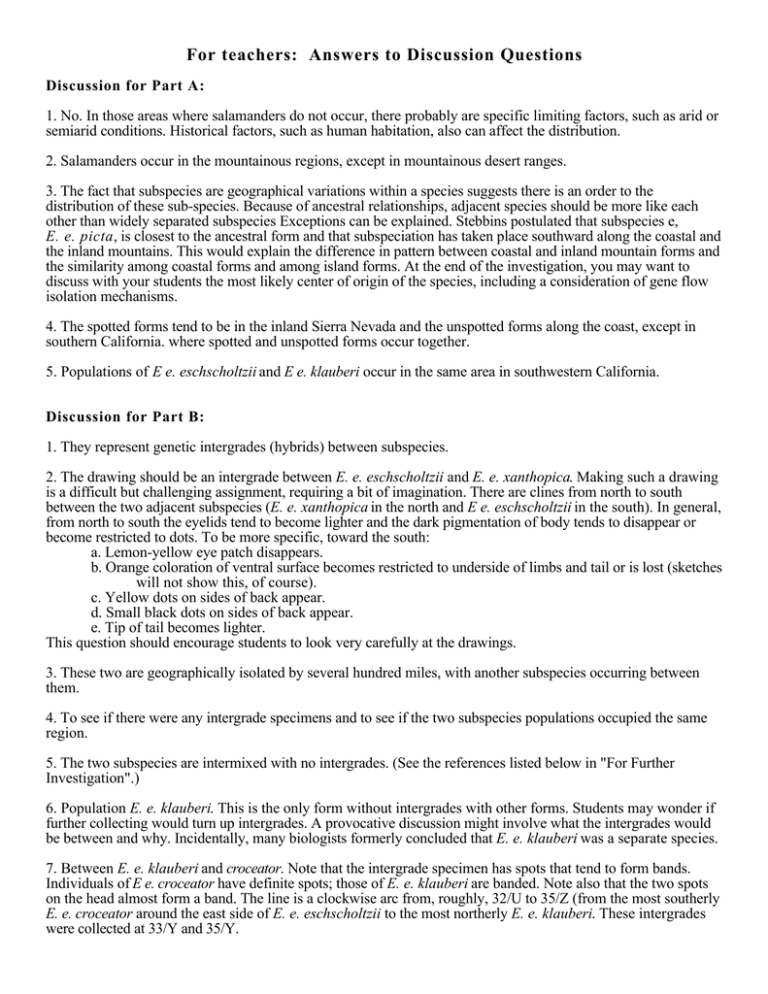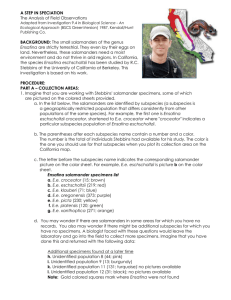For teachers: Answers to Discussion Questions
advertisement

For teachers: Answers to Discussion Questions Discussion for Part A: 1. No. In those areas where salamanders do not occur, there probably are specific limiting factors, such as arid or semiarid conditions. Historical factors, such as human habitation, also can affect the distribution. 2. Salamanders occur in the mountainous regions, except in mountainous desert ranges. 3. The fact that subspecies are geographical variations within a species suggests there is an order to the distribution of these sub-species. Because of ancestral relationships, adjacent species should be more like each other than widely separated subspecies Exceptions can be explained. Stebbins postulated that subspecies e, E. e. picta, is closest to the ancestral form and that subspeciation has taken place southward along the coastal and the inland mountains. This would explain the difference in pattern between coastal and inland mountain forms and the similarity among coastal forms and among island forms. At the end of the investigation, you may want to discuss with your students the most likely center of origin of the species, including a consideration of gene flow isolation mechanisms. 4. The spotted forms tend to be in the inland Sierra Nevada and the unspotted forms along the coast, except in southern California. where spotted and unspotted forms occur together. 5. Populations of E e. eschscholtzii and E e. klauberi occur in the same area in southwestern California. Discussion for Part B: 1. They represent genetic intergrades (hybrids) between subspecies. 2. The drawing should be an intergrade between E. e. eschscholtzii and E. e. xanthopica. Making such a drawing is a difficult but challenging assignment, requiring a bit of imagination. There are clines from north to south between the two adjacent subspecies (E. e. xanthopica in the north and E e. eschscholtzii in the south). In general, from north to south the eyelids tend to become lighter and the dark pigmentation of body tends to disappear or become restricted to dots. To be more specific, toward the south: a. Lemon-yellow eye patch disappears. b. Orange coloration of ventral surface becomes restricted to underside of limbs and tail or is lost (sketches will not show this, of course). c. Yellow dots on sides of back appear. d. Small black dots on sides of back appear. e. Tip of tail becomes lighter. This question should encourage students to look very carefully at the drawings. 3. These two are geographically isolated by several hundred miles, with another subspecies occurring between them. 4. To see if there were any intergrade specimens and to see if the two subspecies populations occupied the same region. 5. The two subspecies are intermixed with no intergrades. (See the references listed below in "For Further Investigation".) 6. Population E. e. klauberi. This is the only form without intergrades with other forms. Students may wonder if further collecting would turn up intergrades. A provocative discussion might involve what the intergrades would be between and why. Incidentally, many biologists formerly concluded that E. e. klauberi was a separate species. 7. Between E. e. klauberi and croceator. Note that the intergrade specimen has spots that tend to form bands. Individuals of E e. croceator have definite spots; those of E. e. klauberi are banded. Note also that the two spots on the head almost form a band. The line is a clockwise arc from, roughly, 32/U to 35/Z (from the most southerly E. e. croceator around the east side of E. e. eschscholtzii to the most northerly E. e. klauberi. These intergrades were collected at 33/Y and 35/Y. 8. The map shows intergrades between all the subspecies except the two that exist together in southern California. It would seem likely that subspeciation has taken place from a common ancestor in the north (closely related to E. e. picta), down the two separated mountain chains. The two subspecies that exist together without intergrading must have become so different from each other that they are reproductively isolated. You can see why these two were thought to be separate species before all the information on the intergrades was available. These species "rings" and "loops" may be a nuisance to a biologist who merely wants to classify objects, but they are exciting to a student of evolution. 9. It would break the chain of interbreeding subspecies because E. e. eschscholtzii and E. e. klauberi at the southern end of the range do not interbreed. This would produce two reproductively isolated populations—two species. For Further Investigation There are several possible explanations. The specimen may have been introduced accidentally by humans, or irrigation in this region may have allowed the specimen to move across the broad valley. More intensive collecting in the valiey might show more specimens in the inland mountains, with perhaps a connection between the coastal and inland populations in the not too distant past. In actuality, more than just this one individual were located in the inland mountains, in thk same general region. Consult: D. B. Wake and K. P. Yanev, "Geographic Variation in Allozymes in a 'Ring' Species, the Plethodontid Salamander Ensatina eschscholtzii of Western North America," Evolution 40 (1986): 702-715, and D. B. Wake, et al., "Intraspecific Sympatry in a 'Ring' Species, the Plethodontid Salamander Ensatina eschscholtzii in Southern California," Evolution 40 (1986): 866-868.






